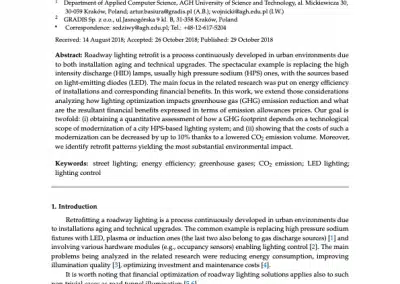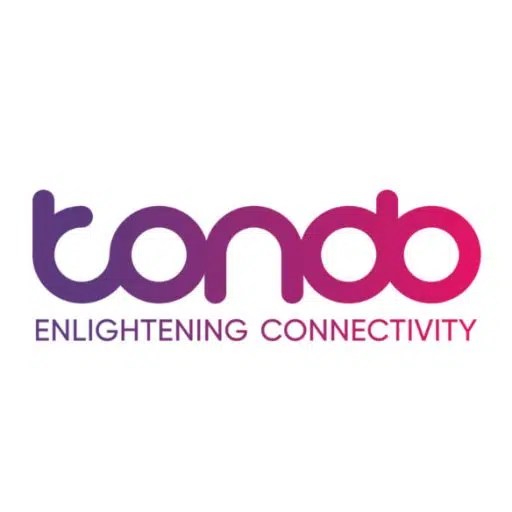Tondo Blog
The Tondo team includes highly experienced leaders in outdoor lighting, IoT technology, information security, artificial intelligence, and business analytics.
This is where you’ll find our thoughts on the current and future state of Smart Lighting and Smart City systems.
The Business Case for Smart Street Lighting as the Smart City Network
Owners and managers of street and area lighting need high quality, reliable information to support informed decisions about Smart Lighting and Smart City-related projects. Until now, most of this information has either been scattered across a vast number of academic studies, or websites with unsourced information and marketing-speak.
This article is intended to provide a supportable, accurate framework to help answer these questions: “Why should our organization care about Smart Street Lighting? What do street lights have to do with our Smart City vision?”
The Benefits of Smart Street Lighting
This article is meant for those who build their own internal business cases or read them in the course of their work. If that’s not you, here is the bottom-line:
- Move street and area lighting from unmetered to metered rates and cut energy costs by 50% or more. [Jump to Section]
- Enable cities to deliver standards-based lighting based on demand, resulting in a savings of up to 70%. [Jump to Section]
- Network-controlled Smart Lighting has been shown to reduce non-electricity operating costs of managing street lighting by 50%. [Jump to Section]
- Extend the life of LED lamps by 60%-70%. [Jump to Section]
- To cost-effectively enable a Smart City strategy, cities require secure, standards-based wireless networks for sensors and devices to operate on.
- Reduce the cost of sensor and device operations by 60% or more. [Jump to Section]
- A positive cash flow budget benefit with a typical project break-even of less than five years. [Jump to Section]
- When you add sensors to the Tondo Smart Lighting project, the IRR can triple and increase the recurring annual benefit by 2.7x [Jump to Section]
- Smart Lighting provides over 85% of the benefits versus LED retrofit
- Smart City sensor networks can increase Smart Lighting benefits by 1.7x. [Jump to Section]
Additional non-financial benefits of Tondo’s Smart Lighting include:
- Advanced cybersecurity for managing critical infrastructure
- A unified cloud-native management platform for all connected Smart City sensors, devices, cameras and controls
- Reduced light waste impacting nighttime dark sky
- Reduced impact on animal health, migration, and reproduction
- Reduced impact on human mental, physical, and behavioural health
Tondo’s Smart Lighting system provides a complete and secure Smart City network and IoT (“Internet of Things”) management platform based on interoperable, open standards technologies.
Tondo’s standards-based approach enables cities to avoid being locked into proprietary vendor technologies and maximizes the useful life of the Smart City network.
Can Dimming Street Lights Reduce Your Bill?
Although we have had the ability to dim street lights since 1977, it’s not quite that simple.
Lighting is about pedestrian and driver safety – we need standards bodies like ANSI, CSA, and IEC to define the minimum standards that tell cities what is safe. Otherwise we get chaos, risk, and liability.
New standards were developed between 2011 and 2021 that enabled us to deliver safe, standards-based, dimmable lighting. Solutions provided prior to 2021 were based on non-standard proprietary methods that risked both safety and interoperability.
Metered vs Unmetered Electricity Rates
Utilities have typically delivered electricity for streetlighting under an “unmetered” rate for municipalities. These rates assumed that it was impractical to meter individual lights or groups of cabinet-controlled lights, and rates are calculated by the input wattage for a light, multiplied by the number of hours of darkness per month – which assumes “dusk-to-dawn” lighting.
In 2002, the American National Standards Institute (ANSI) published the C12.20 standard for electricity metering. in 2018, ANSI published the C136.50 and C136.52 standards [14] for the accurate measurement of electricity of individual street lights.
In 2022, Measurement Canada published “E-38—Program for granting conditional permission to install and use street lighting luminaires with adaptive controls without the approval, verification and sealing of their embedded measurement technology”, which provides a process for Canadian municipalities to realize the benefits of new energy measurement technologies that conform to ANSI C12.20, C136.50, and C136.52.
We can see from the chart below that street light electricity rate plans may cause cities to pay significantly higher costs for their energy, based on unmetered lighting systems.
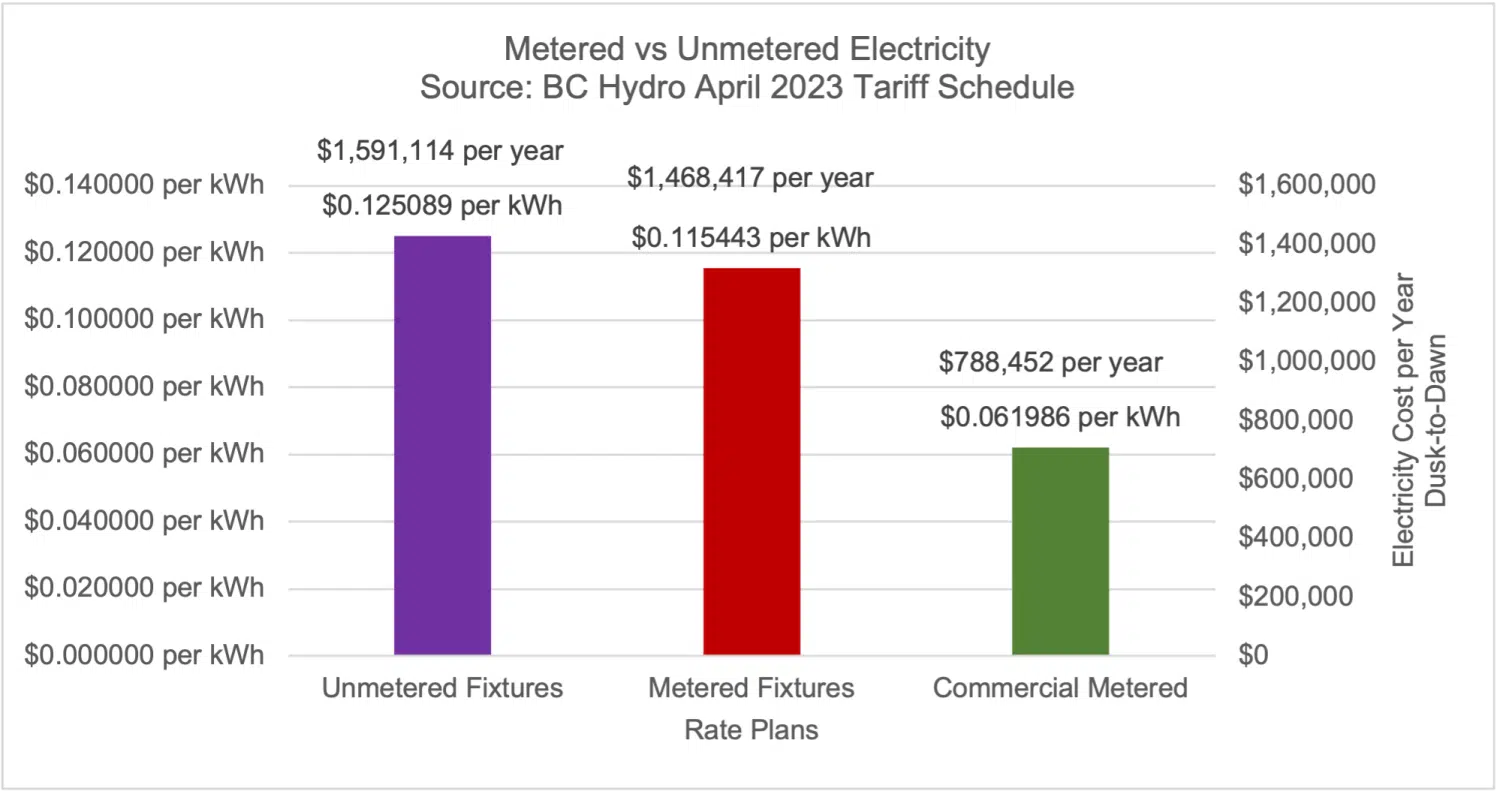
Energy measurement standards for luminaires are relatively new, and initially, it may require cities, Tondo, and utility providers to work together to ensure accurate savings are fully reflected on municipal energy bills. In the case of the BC Hydro rates used in this example, their published Street Light Rates [2] that govern dimming of customer-owned street lighting requires a dimming control schedule to be submitted in advance for approval, and can only be changed twice per year
As such, municipal customers and Tondo will need to work with their utilities and any regulatory organizations to support Smart Lighting controls within their rate schedules.
Time of Use (TOU) Billing
Time of Use billing incentivizes utility customers to use less electricity during high-demand periods, and shift their use to lower-demand periods.
TOU tiered rates help the electrical utilities avoid brown-out, black-out, and manage their costs: electricity is a commodity and costs can fluctuate significantly on demand.
Cities require new technologies that can deliver safe, standards-based lighting, avoid wasted light during low-demand periods, as well as measure their electricity use accurately to audit and manage their billing.
Smart Lighting systems that support ANSI and other regulatory measurement standards can be used by cities to reconcile and audit their electricity billing.
LED Street Lights Still Use A Lot of Energy
It’s highly likely you’ve already written a business case for your LED retrofit project, and it’s either in-progress or completed. The case for LED retrofit is simple: a savings of approximately 34% in energy costs, a 4x longer lamp lifecycle, and a corresponding reduction in lamp replacement truck rolls.
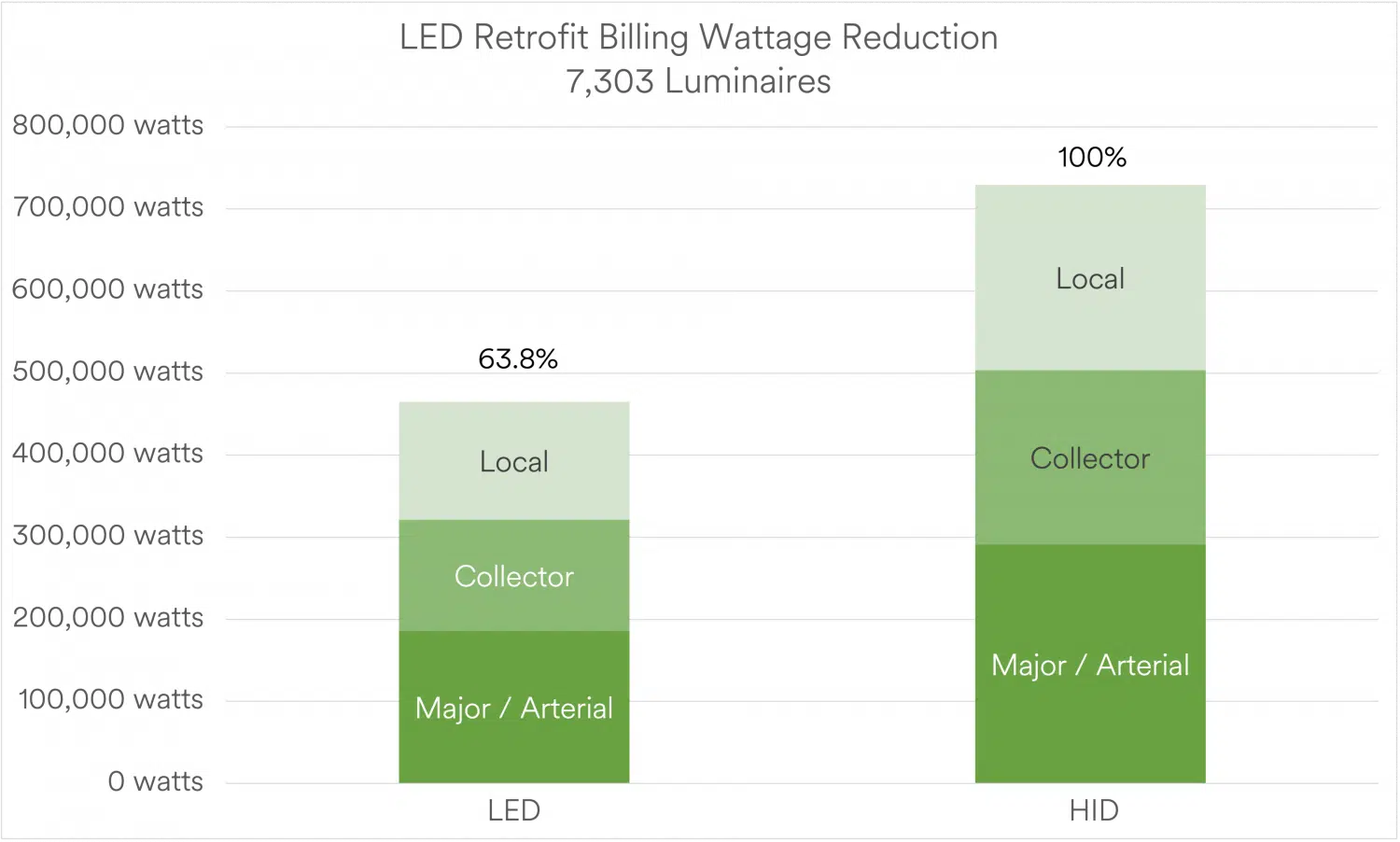
Today, most streetlights are controlled by “dusk-to-dawn” photocells or astronomical clocks to detect night-time conditions. The power to a light pole is most often controlled by wiring cabinets that turn the pole power on and off. When the sun goes down, a photocell or astronomical clock tells the cabinet to power the pole and the lights come on.
Lighting standards provide different levels of light according to pedestrian, driver, and cyclist use. This is often referred to as “adaptive lighting” and requires “smart lighting” in order to implement.
Dusk-to-dawn control wastes more than 60% of streetlight energy by providing light when it is not needed.
Street Light Environments are Dynamic
Dusk-to-dawn streetlight control is not only wasteful, but also delivers sub-standard lighting when it cannot adapt to its environment:
- There are different types of streets serving different transportation needs: local streets, laneways, primary collectors, secondary collectors, primary arterials, secondary arterials, expressways, and different types of highways [5]
- Lighting demand changes based on volumes of vehicle, cyclist, and pedestrian traffic [9]
- Vehicle, pedestrian, and cyclist traffic changes based on time of day, day of week, and the month of the year [15]
- Lighting demand can change for special or unexpected events
- Sunrise and sunset times change not only by season, but by latitude and point relative to the equator [19]
- Weather, pole position, and pavement surface affects the quality of by as much as 240%[17]
- Intersections and crosswalks where pedestrians and vehicles interact have specific lighting requirements [5]
Lamp luminance output – even with LEDs – slowly degrades over time, changing the desired lighting levels. As a result, lamps are:
- Replaced earlier than their useful life
- Must be manually adjusted by dispatching field service calls
- Lighting is purchased over-illuminated at initial installation to compensate for degradation
None of these scenarios are desirable.
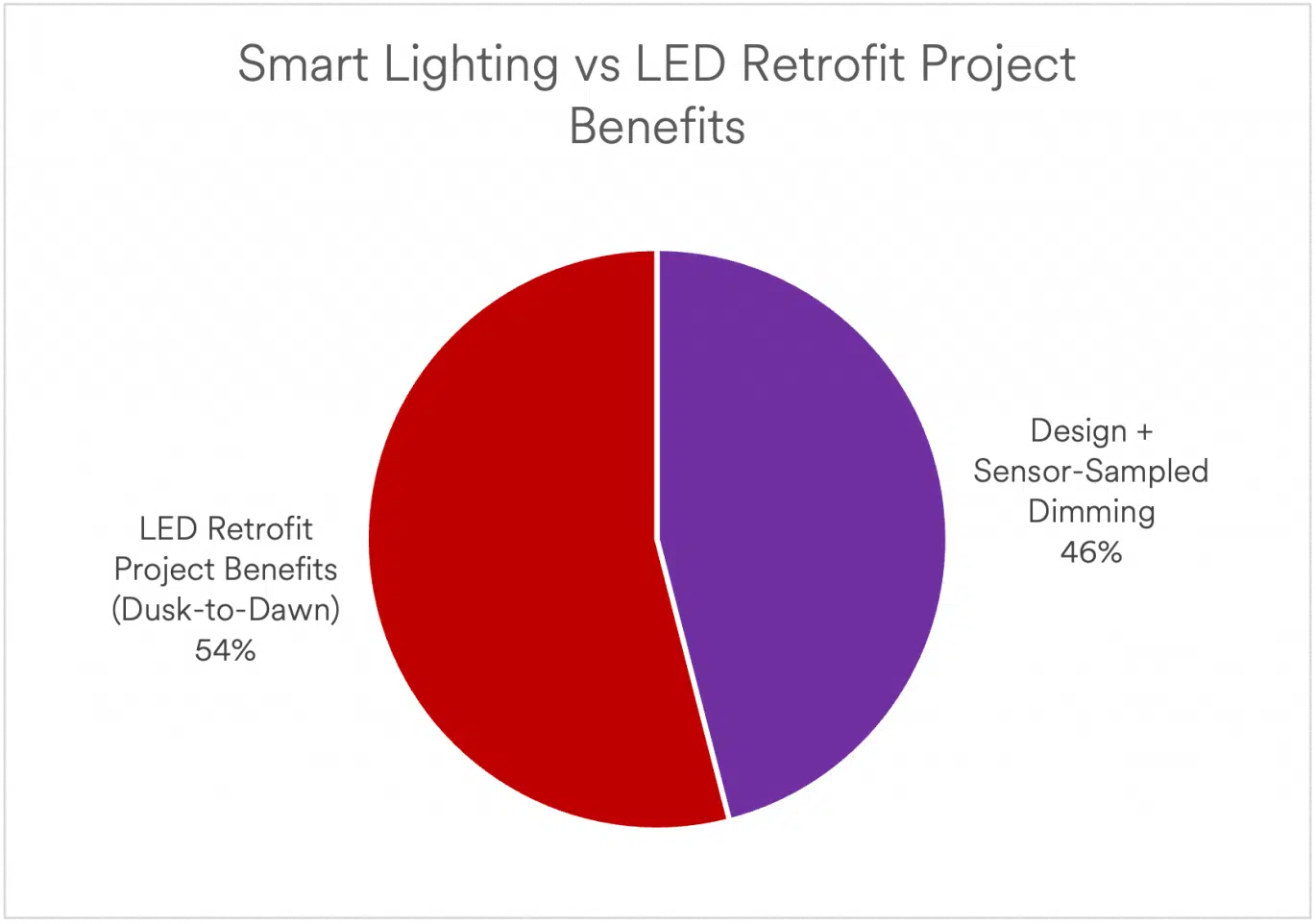
In some cases, municipalities have implemented crude dimming levels according to specific evening times managed by an astronomical clock, such as dimming 50% at midnight to dawn. That approach may result in illumination that does not conform to standards and best-practices, and may present a liability for cities.
Smart Lighting control delivering standards-based lighting on-demand offers significant opportunities for cost-reduction and improved lighting conditions.
Solution: “Smart” Street Lighting
Smart street lighting can adjust light levels according to:
- Roadway classifications set by standards and regulations, such as North America’s ANSI/IES RP-8-21 and Europe’s EN 13201 standards
- Traffic, cyclist, and pedestrian volumes
- Ambient light levels during daylight, dusk, evening, and dawn
- Weather conditions
- Intersections and crosswalks
- Special or unexpected events
- Other safety and security considerations
By delivering standards-compliant lighting on-demand, Smart Lighting becomes a significant source of operational, maintenance, electricity, GHG savings – and safety.
How Can We Dim Street Lights Safely?
The short answer: by applying the established roadway lighting standards using Smart Lighting controls to roadway and pedestrian demand.
The purpose of street lighting is to provide safe and secure environments for drivers, cyclists, and pedestrians. This is particularly important where they interact with each other. When demand drops, roadway lighting standards allow cities to consider lower illumination levels.
Let’s step through a case using the North American ANSI/IES RP-8-22 standard for roadway lighting and apply it to a city’s real-world data. [1]
This Canadian city has a population of 92,000 people over 20km sq. and has 7,303 street lights with 99.3% of them upgraded to LED lamps.
The chart below shows the city’s share of roadway by ANSI/IES RP-8-22 standard classification type:
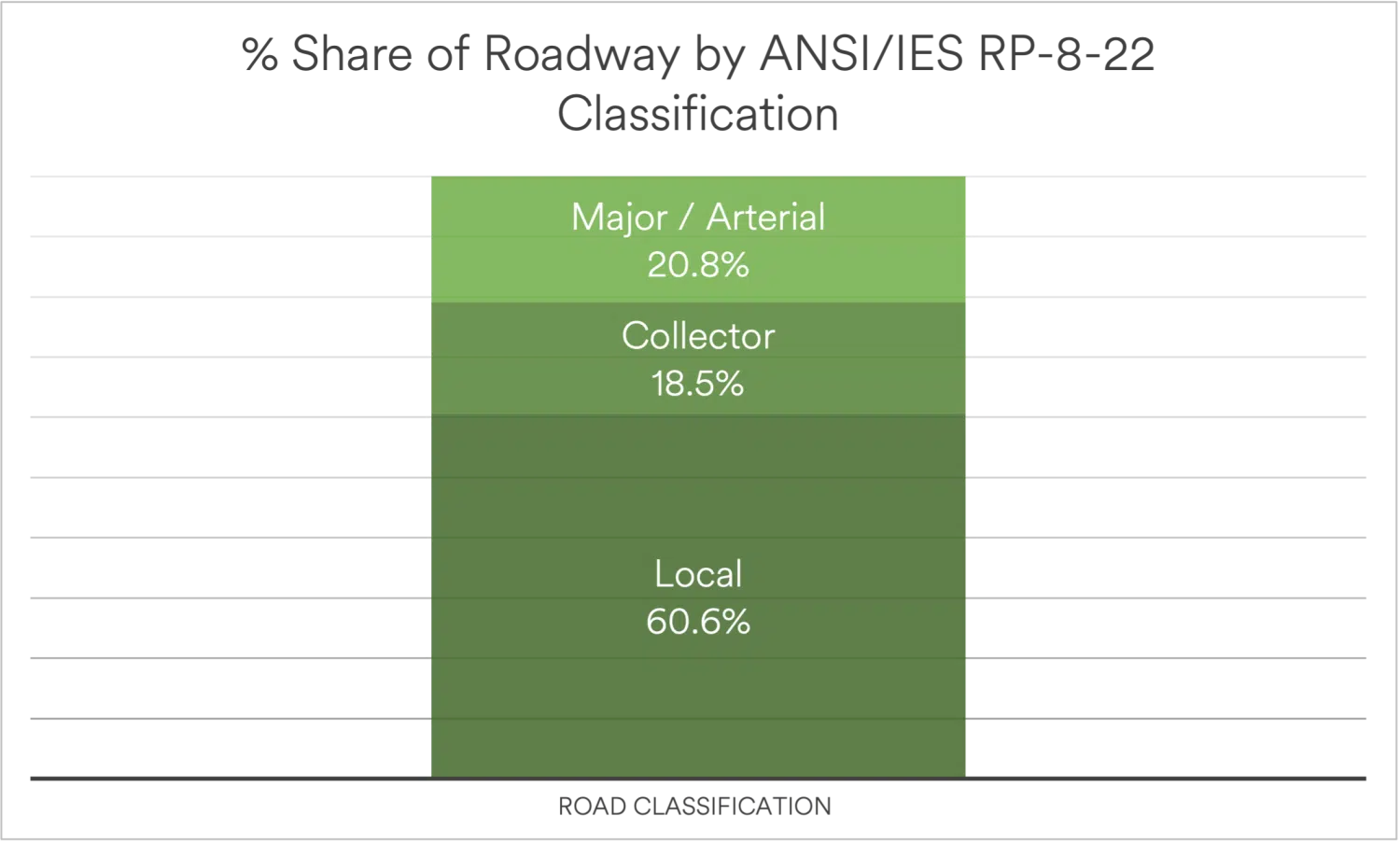
Next, when we look at the vehicle traffic volumes during Dusk-to-Dawn periods, we can also see from this chart:
- Most traffic volumes are low traffic periods
- Demand changes for each day of the week
As a result, lighting standards provide for lower lighting levels where there is a lower probability for pedestrian-vehicle conflict.
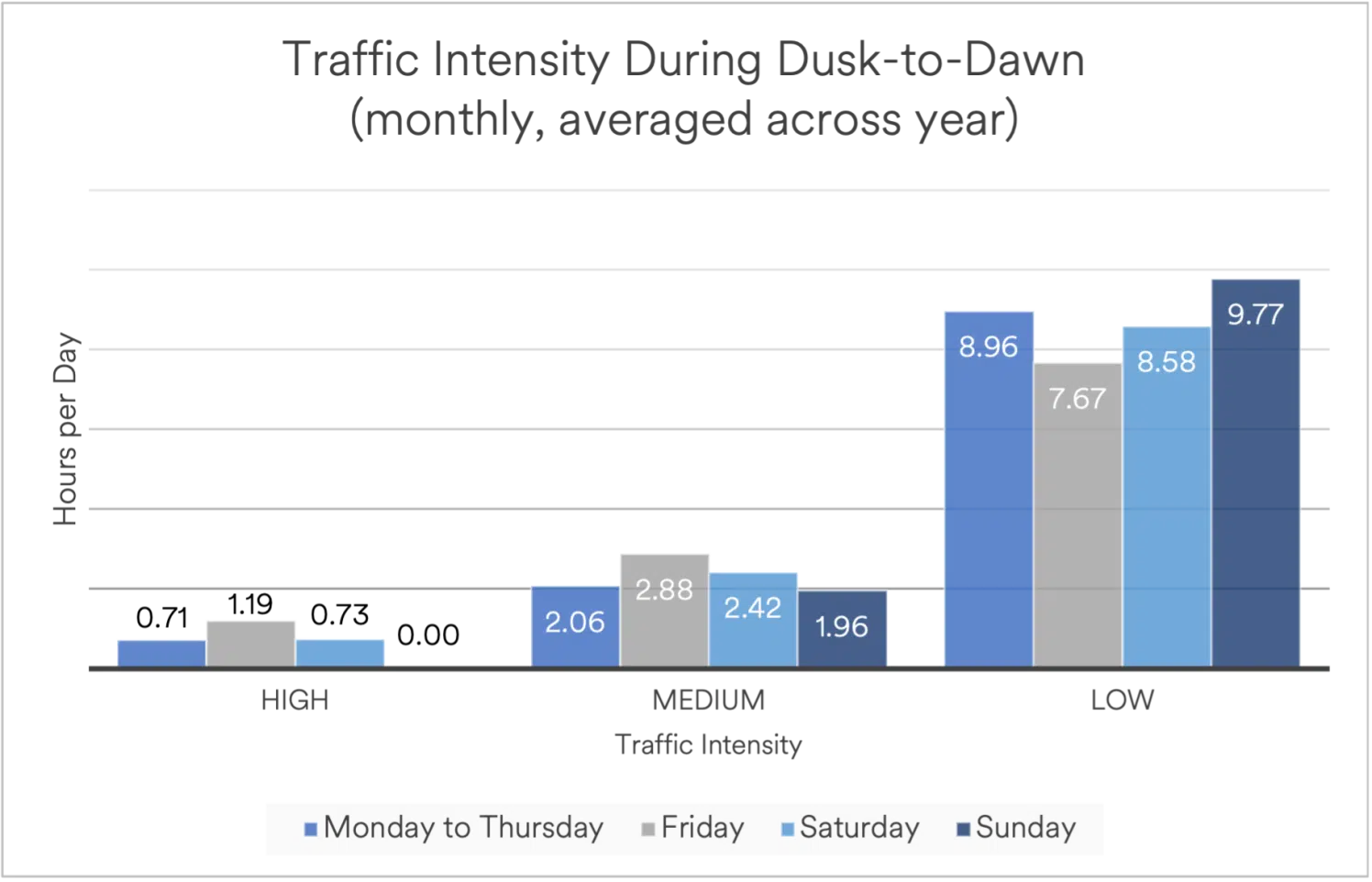
In this last chart, we can see an example of the luminance standards and best-practices from the ANSI/IES RP-8-22 standard, “Lighting Roadway And Parking Facilities”. This standard is used for roadway lighting design in North America [5]. Here, we are looking at the required luminance level for a Local road with an R2 or R3 surface. These are asphalt surfaces commonly used in North America for local roads with low, medium, and high pedestrian sidewalk traffic.
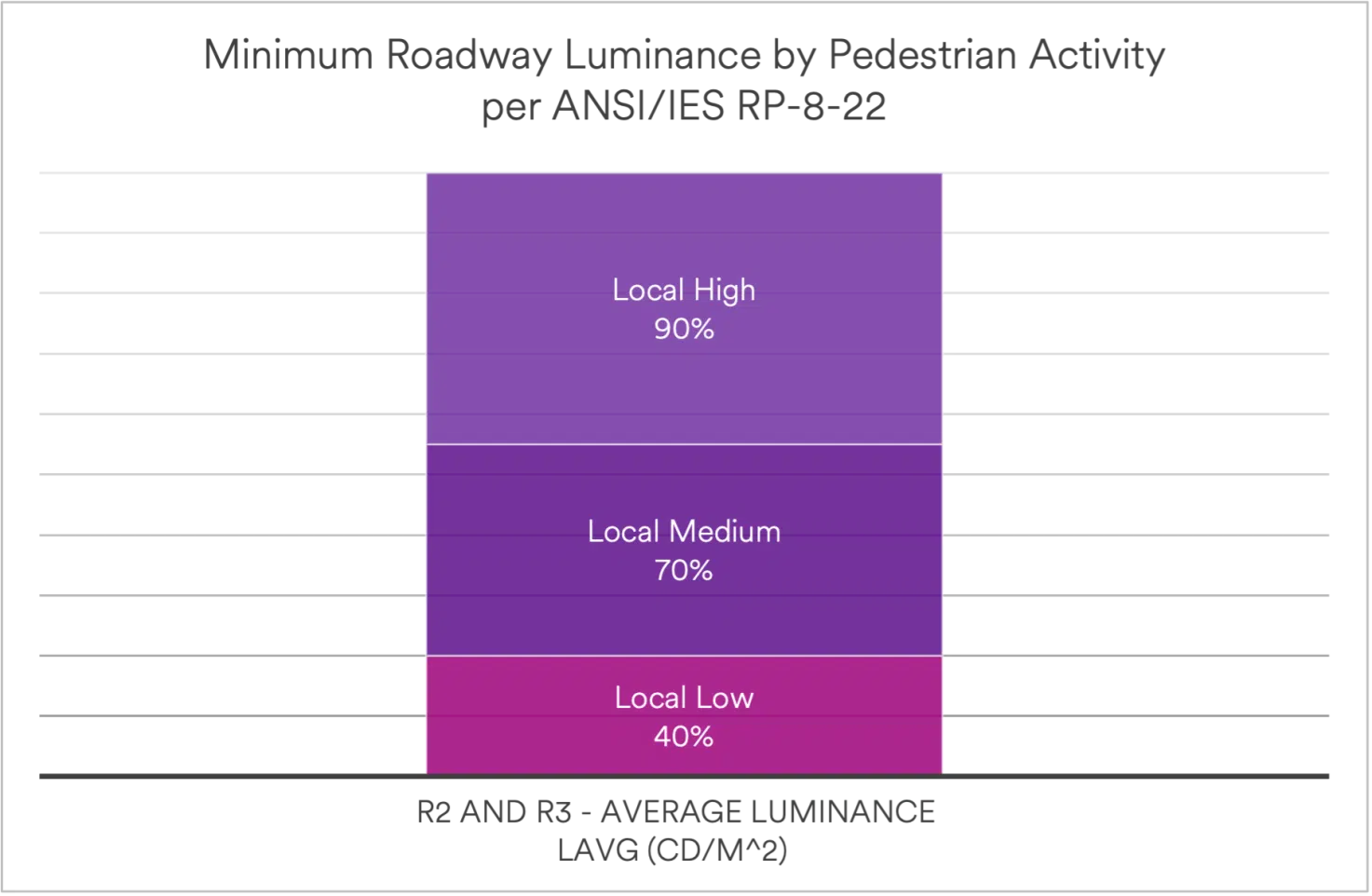
When we put all this data together, we see that 60% of the city’s roadway lighting can be dimmed 75%-80% of evening hours by as much as 80% of the time compared with peak hour demand. This is the basis for the benefits of dimming street and area lighting.
Smart Street lighting enables lighting designers, engineers, and a city’s operations team to deliver standards-based lighting levels based on the unique composition of their city’s roadway system.
Not All Street Light Dimming is Equal
There are several methods of dimming available [6], [7], [8] with Tondo’s Smart Lighting system. Savings factors from several academic studies were used in our business case:
- Design-Based – based on dimming-enabled photometric design
- Statistical – based on historical traffic volumes with all days of week equal
- Statistical Categorization – based on historical traffic volumes, each day of week is unique
- Sensor Sampled – sensors used to sample traffic volumes in in 15-minute intervals
Lighting designers and engineers can utilize software applications such as DIALux to design street lighting projects according to established standards. However, Smart Lighting controls are required to apply these designs. Lamps and luminaires have different lighting characteristics, must respond to traffic pattern changes, and adjust output according to lamp luminance that degrades over time.
The photometric Design-based dimming is intended to be used together with one of the three adaptive traffic-based dimming methods: Simple Statistical, Categorized Statistical, or Sensor-Based.
These four methods of Smart Lighting-enabled dimming are compared in the chart below relative to Dusk-to-Dawn operating costs for:
- Electricity use based on unmetered street light rates [2]
- Electricity use based on metered street light rates [2]
- GHG footprint measured in CO2 equivalents and available carbon credits [3],[4]
- Increased LED lamp lifecycles from dimming [10], [16]
- Reduced luminaire maintenance truck rolls [11], [12], [13]
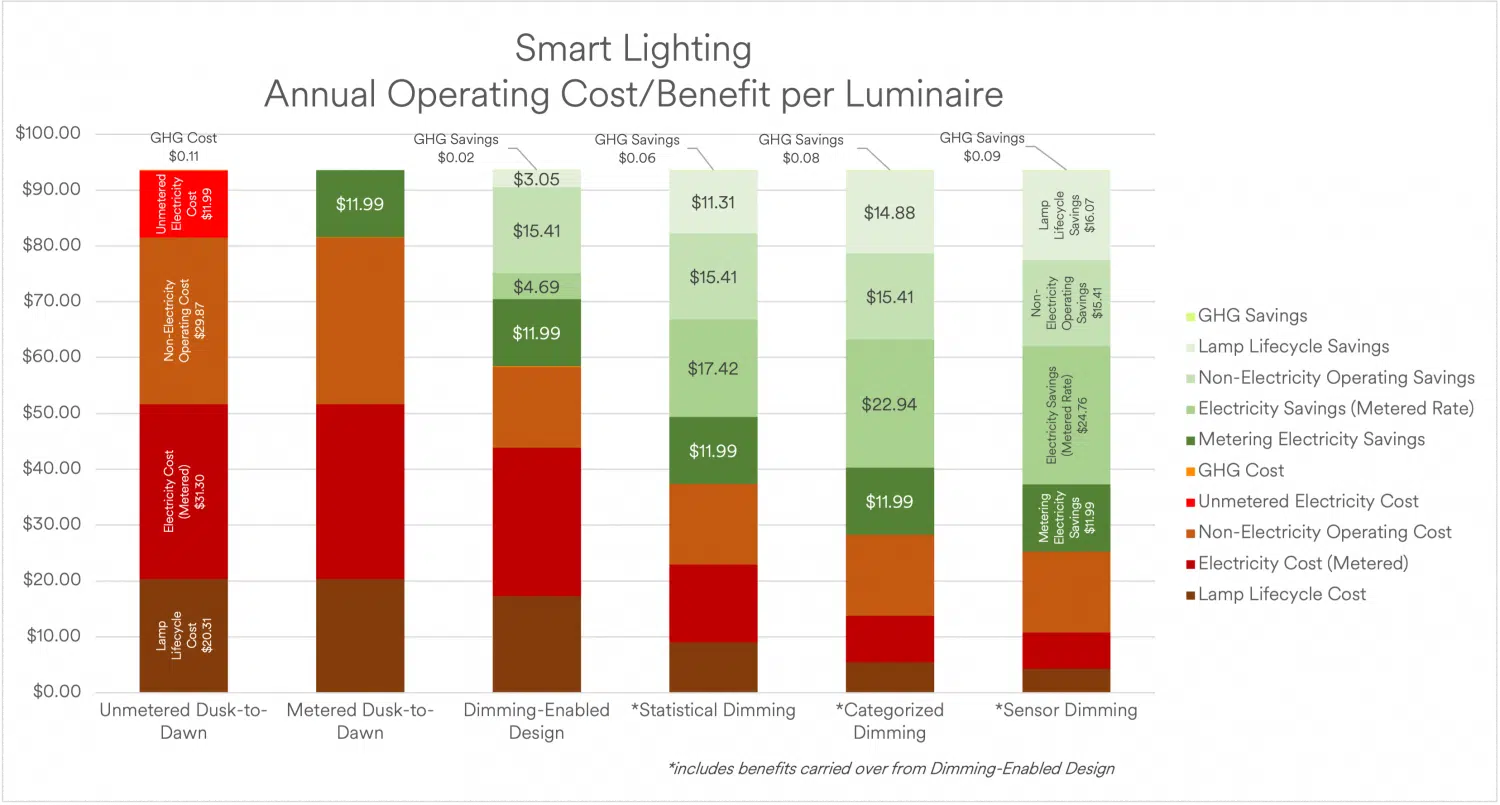
Let’s zoom in on the value that the three dimming methods plus dimming-enabled photometric design create:
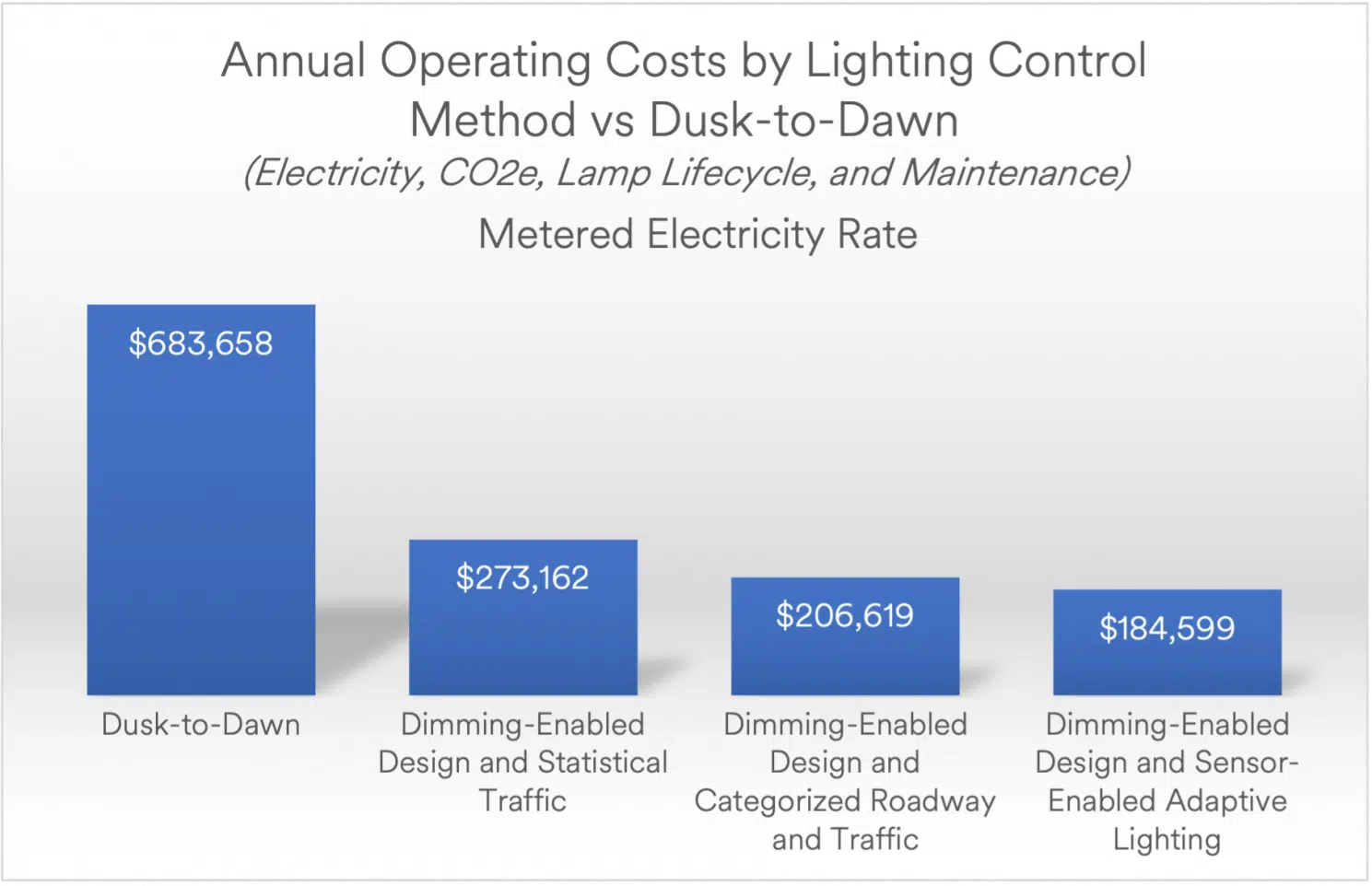
But that’s not all – we still need to look at the non-electrical operating expense of street light maintenance.
How to Reduce Street Light Maintenance Costs with Smart Lighting
Managing street and area lighting is a lot of work. It is also regulated by safety authorities at the state/provincial and national levels, and subject to regulatory standards.
Maintenance involves both routine and non-routine maintenance activities. These routine activities include:
- Inspection, testing, cleaning, lubricating, and performing minor repairs as needed
- Regular visual inspection as part of the replacement of lamps
- Replacement of luminaires and lamps according to expected lifecycles
- Testing for voltage and current leakage that can put the public or wildlife at risk
However, there are a number of non-routine activities that include investigating:
- Wire down
- Pole down
- Power supply down
- Power supply failure
- Wiring faults
- Energization of surfaces accessible by the public
- Vandalism
- Faulty lamp or luminaire
- Electricity theft
The transition from older high intensity discharge (HID) lighting to LED lighting addresses the routine maintenance activity of replacing lamps. In addition, Tondo’s Smart Lighting controllers are designed to identify:
- Faulty luminaires
- Pole down from tilt
- Damage to pole or luminaires from weather, vehicle collision, or vandalism
- Wiring faults at installation time or degradation over time
- Electricity theft
- Power quality that can indicate risk to the public
How do we measure these costs?
For the purpose of this business case, we wanted objective third-party data without using our own assumptions. There were a number of studies that suffered from problems in their methodology, and we looked for:
- Real world measurements
- Completeness and scope of analysis
- Published date
- Detailed cost analysis using real-world city data
The studies [11, 13, 21] show that Smart Lighting technology can save up to 50% in lighting maintenance costs.
Tondo’s Cloud-IQ central management software system collects data from lighting controllers and sensors, and provides actionable analytics and alerts to non-routine conditions to cities.
At this point, the business case becomes obvious for Smart Lighting. This brings us to the question of, “What is the value of Smart Lighting as the platform for a Smart City sensor network?“
The Street Light-Enabled Smart City Network
There are many definitions of what a Smart City is, and the definitions continue to evolve. A fair summary of the Smart City definition is a city that:
- Supports operational efficiencies through technology-based automation
- Supports economic growth through the provision of technology infrastructure
- Supports citizen satisfaction with high-availability self-service for city services
- Supports community development through education, sharing resources
- Supports citizen engagement through connection with city representatives and voting
- Decreases the human impact of growing urbanization on our environment and wildlife
- Improves safety and security
- Supports equal access to city resources for all citizens
A Smart City uses technologies and innovation to reduce the impact of urban growth on our environment and improve service efficiencies, citizen engagement, community development, education, and economic growth for the benefit of all citizens and businesses.
So how can a Smart Lighting-enabled Smart City Network help?
A Smart City Without Smart Lighting?
Before a Smart City vision can be realized, cities need a cost-effective, secure, wireless, city-wide communications platform (“network”). This will use a variety of sensors and devices to support Smart City process automation and efficiency.
Street lighting is the natural platform for the Smart City network:
- Street lighting is everywhere there are infrastructure assets, people, and vehicles
- Street poles are pre-wired for power
- Streetlight poles are high up in the air for optimal wireless network position
- Streetlight poles are convenient locations for a wide range of sensors and devices
- Streetlight poles are co-located to underground city infrastructure
- Connection standards already exist to connect network controllers to street lights
Lighting poles represent strategic infrastructure for smart city development, thanks to their capillarity, connectivity and electrification.
The evolution of the street lighting market, Arthur D. Little S.A., October 2019
Tondo’s Smart Lighting creates a secure, open standards-based city-wide network. This enables control over lighting, and also enables cost-effective connectivity for wireless sensors and devices that support Smart City goals.
Smart Cities Need Sensors
Smart Lighting directly and materially reduces the human impact of growing urbanization on our environment and wildlife:
- Reduced energy use and GHG footprint
- Reduced sky-glow that impacts human health, animal and bird migration and reproduction
- Improved aesthetic and scientific research value of a dark night-time sky
Operational efficiencies, economic growth, improved safety and security, and citizen self-service delivery for Smart Cities depends on better information – faster. Sensors help cities gather data to more effectively manage a range of services including:
- Transportation
- Flood control
- Water quality
- Gas or fluid leak detection
- Sanitation services
- Parking occupancy
- City asset theft or vandalism
- Air quality
- Public safety and first-responder resource management
- Infrastructure health and degradation
Most sensors today require proprietary technologies and multiple stand-alone platforms for managing devices and data. These approaches present two major risks for cities:
- An economic hold-up problem locking cities into purchasing devices through that vendor. There are few* examples of vendors who have decreased their SaaS prices as they have gotten larger and increased their economies of scale.
- A technical hold-up problem locking cities into purchasing devices that are compatible with a proprietary technology platform. There are few* examples of proprietary technologies that have survived after open standards have been established.
* I will argue “none” in the 40 years I have been working in the technology sector.
With Tondo’s open, standards-based network and management platform, the city is not locked in to a specific vendor’s products – including Tondo’s.
Controlling Smart City Sensor Costs
Let’s look at a manhole cover use-case as an example. Why manhole covers instead of water quality, gas leak detection, storm drain levels, or many other use-cases? This article in the New York Times caught my eye recently: Where have all the manhole covers gone? .
Manhole sensors cost hundreds or in some cases, thousands of dollars, with monitoring fees charged monthly. When the number of sensors is relatively low, the operational costs of these sensors are not always noticeable. SaaS or monitoring costs from $10 to $50 or more per sensor per month charged by some vendors make city-scale projects uneconomical.
The city that was used for street and lighting data in this article [1] has 7,303 standard light pole street lights, 2,537 city street blocks, and 269 crosswalk-marked intersections. The city also has 4,060 sewer manholes and 3,444 storm drain manholes for a total of 7,504 manholes – more manholes than street lights.
The value of a Tondo Smart Lighting-enabled Smart City network for sensor and device connectivity is based on the costs of the network offset by the operating cost savings from street lighting.
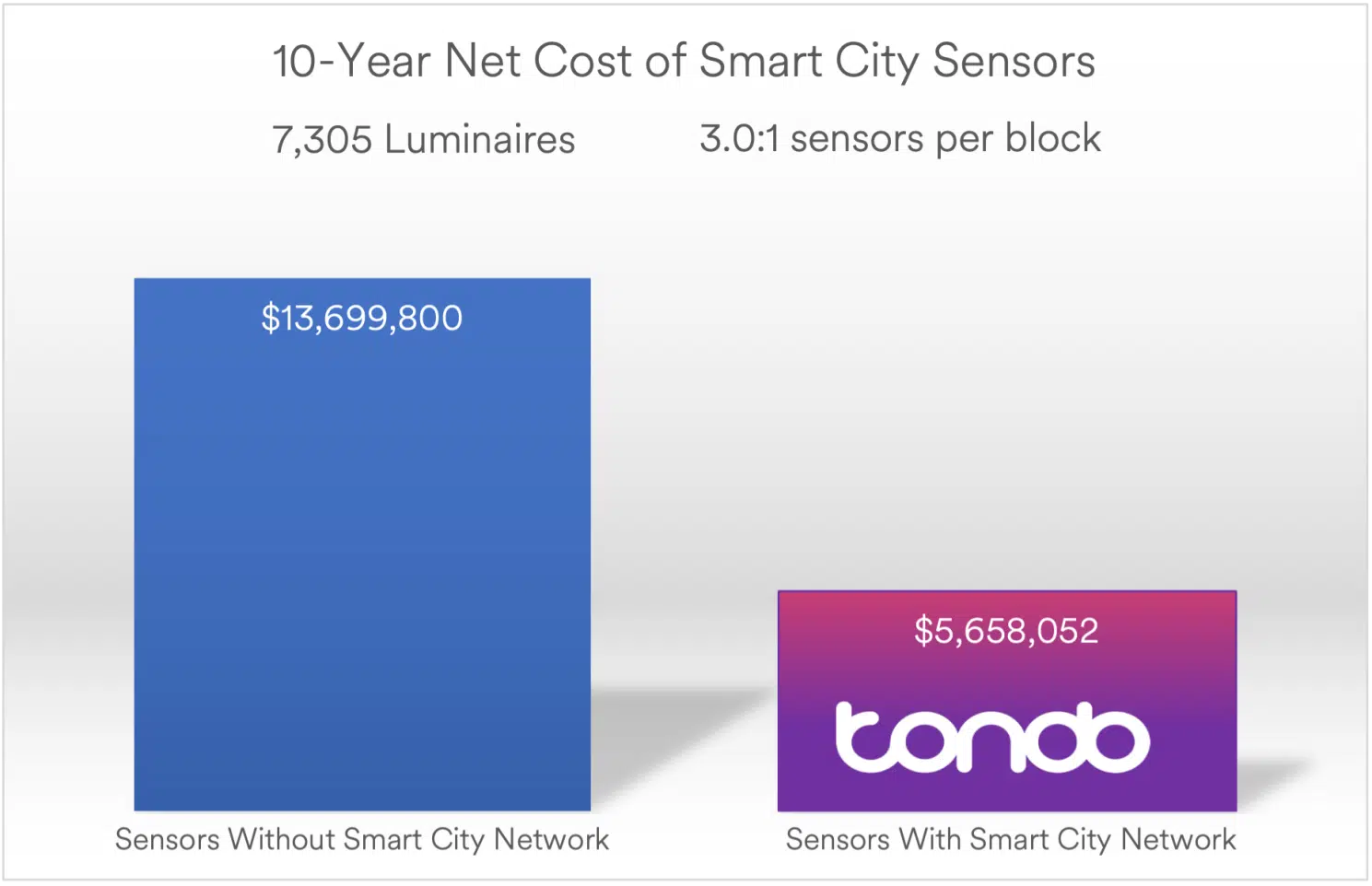
Tondo’s Smart Lighting creates a net cash-flow positive Smart City sensor platform that prevents costs from spiralling out of control.
Tondo’s Smart Lighting creates a secure city-wide network that not only enables control over lighting, but also enables connectivity for wireless sensors and other connected devices that enable Smart City applications.
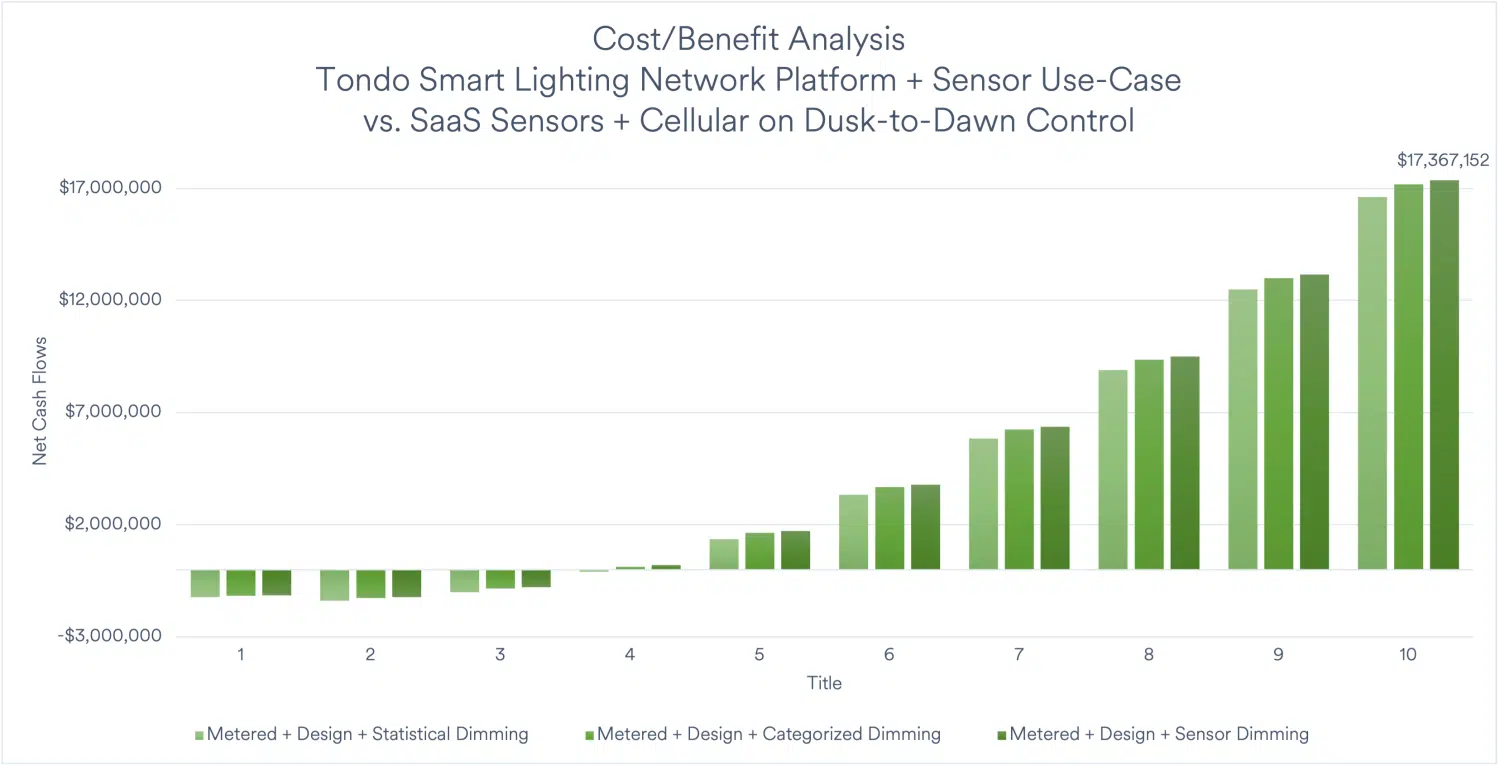
This cash-flow positive Tondo’s Smart Lighting solution for 7,303 luminaires on 2,537 city blocks offsets the cost of the Smart City network, showing a project IRR of 13.8% without including savings from sensor deployment, and 52.6% when including sensors in the analysis. The break-even for Smart Lighting only is 4.5 years, and this drops to 4 years with a three sensor-per-city-block project – and avoids over $17m in future costs.
The Business Case for Smart Lighting as the Smart City Network
This is a lot of information to take in. The first barrier to reducing energy costs, operating costs, and the GHG footprint of our energy use is reliable information.
The key takeaways from this case are:
- Tondo’s solutions can enable its customers to move lighting from unmetered to metered rates and cut their energy costs by 50% or more. [Jump to Section]
- Tondo’s Smart Lighting enables cities to deliver standards-based lighting according to demand, resulting in a savings of 70%. [Jump to Section]
- Network-controlled Smart Lighting has been shown to reduce non-electricity operating costs of managing street lighting by 50%. [Jump to Section]
- The reduction in electricity use from adaptive dimming also extends the life of LED lamps by 60%-70%. [Jump to Section]
- To cost-effectively enable a Smart City strategy, cities require secure, standards-based wireless networks for sensors and devices to operate on. Tondo’s Smart Lighting controllers include a secure city-wide wireless network platform that can reduce the cost of sensor and device operations by 80%.
- A Tondo Smart Lighting project provides a positive cash flow budget benefit with a 10%+ internal rate of return (IRR) and a project break-even of less than 5 years. [Jump to Section]
- A Tondo Smart Lighting sensor network can triple project IRR and increase the annual benefit by 2.8x [Jump to Section]
- A Tondo Smart Lighting project provides 85% of the benefits versus LED retrofit, and a Smart City sensor network project can provide 280% of LED retrofit benefits. [Jump to Section]
If you have questions or comments for us on this article, please contact us through the Contact Us form on our website at www.tondostaging.wpengine.com.
A Tondo Smart Lighting-enabled Smart City sensor network will provide municipalities with significant long-term value, and establish their platform for Smart City enablement.
Methodology, Sensitivities, and Assumptions
This article is based on a comprehensive economic model developed internally at Tondo. It uses a city’s ArcGIS data, Google Maps data, and established street lighting standards to accurately assess the costs and benefits of Tondo’s Smart Lighting and Smart City network projects. However, there are a number of assumptions and input values that may cause significant changes to these predicted values.
Sensitivities for this business case include but are not limited to:
- Changes to ANSI/IES RP-8-21 roadway lighting standards [1]
- Cost of electricity [2]
- Composition of lighting assets and corresponding input wattage [1]
- CO2 footprint of electricity [3]
- Cost of CO2 carbon credits if available [4]
- Additional project management, provisioning, and configuration costs
- Cost of third-party software integration
- Any custom software or hardware development required in a project
- Capital cost of sensors [14]
- Number of luminaires [1]
- Crosswalk-based intersections [1]
- Number of streets for each road surface and classification [1]
- Currency conversion rates between Canadian and U.S. dollars, if applicable
- Assumptions for sensor ratio to number of city blocks used in the case [1]
- SaaS cost assumptions for proprietary sensor solutions used in the case [14]
- Non-standard lighting levels required by city practices
- Assumption that all existing city luminaires support dimming control and industry-standard connections
Although it is not practical to cover all aspects of our business case model in this article, our internal model does allow for us to tailor these and other assumptions for a specific use-case.
If you are interested in having your city’s data used to produce a similar cost-benefit analysis of your own Smart Lighting and Smart City Network initiative, please contact us through this website and we would be happy to help.
Citations and Sources.
[1] Data sample used for composition of Streets, Intersections, Manholes, Lamps, and Luminaires
[3] Greenhouse Gas / CO2e footprint per kWh, Government of British Columbia, January 2023
[4] Greenhouse Gas / CO2e costs, Government of British Columbia, January 2023
[9] Traffic volume classifications re: ANSI/IES RP-8-21: District of North VancouverRoadway Lighting Retrofit: Environmental and Economic Impact of Greenhouse Gases Footprint Reduction
[12] BC Hydro street light service rates
[14] Cost of manhole cover sensors: City of Torrance, CA RFP
[15] Effects of high traffic flow on dimmable hours, data sampled by author from Google Maps 2022
[16] Impact of luminaire models on optical efficiency/lumens per watt: AcuityBrands ATB0 luminaire technical specifications, 2022
[18] Maryland Energy Administration, Municipal Street Light Program, Summer 2021
[19] Sunrise calculation, Wikipedia, 2023
[20] ANSI C136.50 Energy Measurement For A Network Lighting Control (NLC) Device With A Locking-Type Receptacle, and C136.52 Metering Performance Requirements for LED Drivers
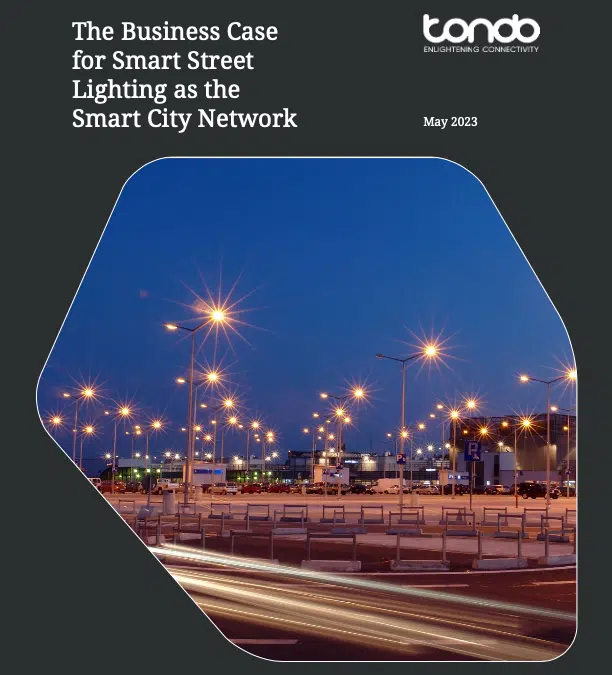
The Business Case for Smart Street Lighting as the Smart City Network
This paper details all of the key components of the business case for Smart Lighting-enabled Smart City networks, including connected sensors and devices.
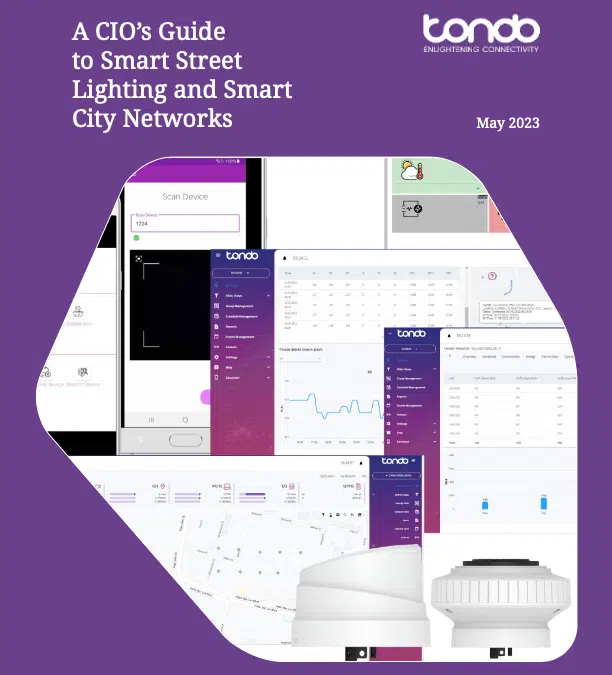
A CIO’s Guide to Smart Street Lighting-Enabled Smart City Networks
CIOs in municipal organizations may benefit from understanding the evolution of street and area
lighting technologies and standards.
This Guide may help CIOs and their teams collaborate on Smart City
initiatives with their organizational peers in Public Works and Engineering departments.
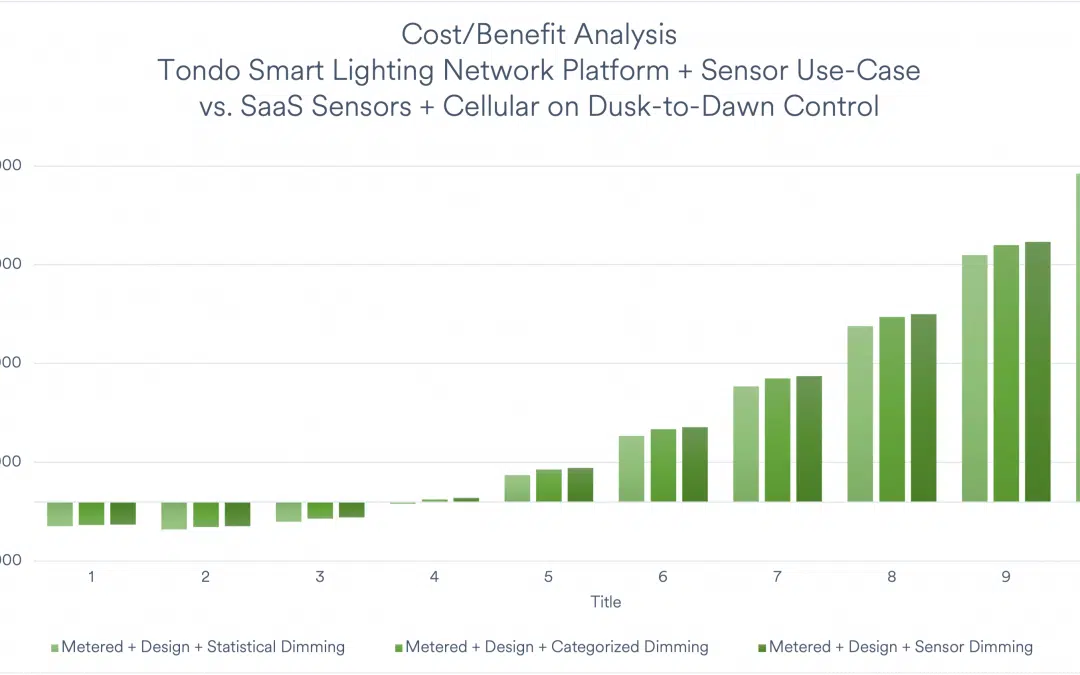
The Business Case for Smart Street Lighting as the Smart City Network
Owners and managers of street and area lighting need high quality, reliable information to support informed decisions about Smart Lighting and Smart City-related projects. Until now, most of this information has either been scattered across a vast number of academic studies, or websites with unsourced information and marketing-speak.
This article is intended to provide a supportable, accurate framework to help answer these questions: “Why should our organization care about Smart Street Lighting? What do street lights have to do with our Smart City vision? “
Recent Articles
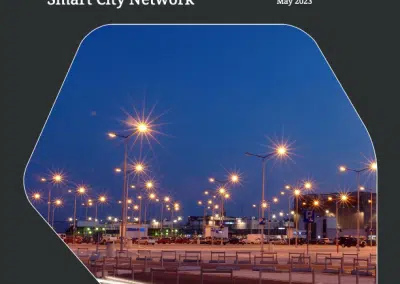
The Business Case for Smart Street Lighting as the Smart City Network
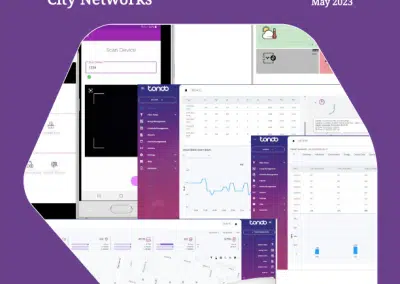
A CIO’s Guide to Smart Street Lighting-Enabled Smart City Networks
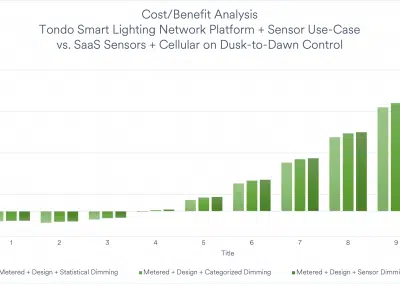
The Business Case for Smart Street Lighting as the Smart City Network
